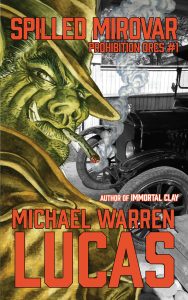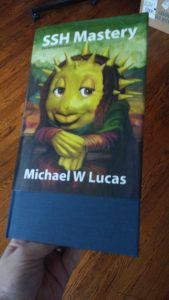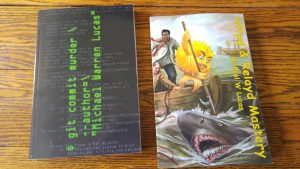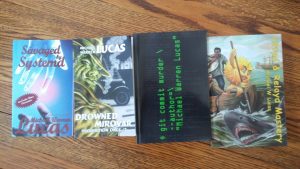Most craft businesses fail. It’s not surprising. Being an expert knitter doesn’t mean you should open a yarn shop. Lots of those hobbyist stores go broke in the first year because the excited, enthusiastic storekeeper doesn’t know how to pay himself and the landlord. In business, cashflow is king.
Writing is a craft business.
Kris Rusch’s writing business blog has a lovely article about business capitalization and implosion. As an IT nerd who survived not one but two dot-com crashes, and as a writer who’s been paid increasing amounts for his work since 1995, I’ve seen exactly this problem hit people in both the technology and writing businesses.
Kris makes wonderful points, but she skipped something. How, exactly, do you manage cashflow in your writing business? Specifically, how do you pay your bills? How do you get groceries in the fridge and pay the copyeditor? How do you decide when you can afford to expand your writing business?
This is roughly how I do it, in both my long-gone consulting career and as a professional writer. I did not invent this method; rather, I accumulated it over decades of largely involuntary exposure to business. It covers how I decided I could afford to become a full-time writer, because that decision is an utterly critical part of cash flow management. There are other methods; I am not offering you the One Word of Truth here.
Every successful business plays some variant of this game. The only difference is how complicated the spreadsheets are.
Premises
You’ll not only have good months and bad months, you’ll have good and bad years. Understand this all the way down into your toes. Burn it into your soul. If you want your business to survive, you must have actionable plans to endure bad years.
Have a business organization, with a separate bank account. Big thick books are written on business organization, and I’m not going to pretend to advise you on the right organization for you. The important thing for this discussion is that the business receives every penny of your writing income. If you’re not doing that, start now.
Start with money in hand. If you don’t have cash in your greasy mitts to pay your bills your business will fail. End of discussion. I had a year’s expenses in my business bank account before I went full-time writer. I accumulated those savings by… wait for it… not spending my writing income. Maybe you have a supportive spouse, and don’t need a full year of expenses. Maybe your savings are in your personal account rather than your business account. Modify my example to fit your reality.
The Cashflow Game
You don’t write for a living. You make a living so you can write, but you play a game for a living. The game is called “Keep The Bucket Full.”
Money irregularly enters the Business Account Bucket. Some months it’ll get a drop or two. Other months, a torrent arrives.
Money leaves the Business Account bucket at an (approximately) fixed rate. Your rent isn’t going to go down just because your books aren’t selling.
When money leaves the Business Bucket faster than the bucket refills, you’re losing.
When money enters the Business Bucket faster than the bucket drains, you’re winning.
Playing the game takes two numbers: how fast the bucket drains, and how fast it fills.
You can be a successful craftsman and produce professional-grade work without playing this game. True professionals are paid, though, and you cannot be a successful professional craftsman without playing the game.
Draining the Bucket
Start with your expenses. Go through your last six months of spending. What do you need, and what do you want?
Only you know how much money you need to pay your bills, and which of your bills are necessary. You require health insurance and you must fund your retirement. I don’t have cable TV, but if you have kids the Disney Channel might well be a wise expenditure. My family lives in Detroit, because of the low cost of living. That might not work for you. On the other hand, my tech writing means I need thirty megabit of bandwidth. You might need much less Internet. You might read a good book on financial decision-making.
Brutally honest self-reflection is essential here. What did you need to spend, what was excessive, and–the hardest category: what did you not strictly need, but you know damn well you’re going to buy anyway even if it’s not in the budget? In my younger days, I most frequently blew my budget by buying books. My budgeting vastly improved once I allowed for that.
Make your choices. You can and will change them later, but at least start.
Perfection isn’t necessary. A starting list is. Preferably, a starting list with pessimistic-but-not-apocalyptic assumptions. Maybe all of my favorite authors will release a book in the same month, increasing expenses, but if I catch wheat rust everything blows up anyway.
Group these expenses into a two-by-two matrix: business and personal, versus “essential” and “stuff you’re willing to surrender if it means you get to keep writing for a living.” Again, you can and will change these later.
| expense categories | business | personal |
| essential | essential business expenses (copyediting, book proof fees, accountant) | base pay (food, rent, health insurance) |
| nice-to-have | full business expenses (better covers, more promotion) | full pay (vacation, pocket cash, someone else to mow the lawn) |
If an expense can be a legitimate business expense, declare it a business expense. This is not a tax blog, so none of this is legal advice, but in general: those writing conferences? Business expense. Microsoft Word and InDesign for your writing PC? Business expense. Lunch while you’re writing? Personal expense–you’d have to eat anyway. Read a book like Tax Savvy for Small Business and consult an accountant.
Arrange them by month or by year. Yearly is more effective for the long view, but many people find monthly more comprehensible. Divide those annual expenses, like tax preparation, by 12. You’ll save money for them throughout the year, so that sudden $500 bill is not a nasty shock to your wallet.
Separately total up the four categories.
Your essential business expenses? That’s how much money the business needs to survive. I’ll call this “essential business expenses.”
Your nice-to-have business expenses? This, plus your essential business expenses, is how much you’d like to spend on the business each month. I’ll call this “full business expenses.”
Your essential expenses? That’s how much you must pay yourself. I’m going to call this “base pay.”
Your nice-to-have expenses? That, plus your base pay, is how much you want to pay yourself. I’m going to call this “full pay.”
Your goal is for the business to pay its full expenses every month, while paying yourself full pay every month.
Armed with this information, visit your accountant. If you’re unsure, ask them to verify the legitimacy of your proposed business expenses. It’s much better to pay a few bucks for a proactive check than have the local tax agencies add you to their list of “Suspicious Bastards We Need To Closely Watch.” Then have the accountant look at your base and full pay. How much must you to pay in taxes to pay yourself each of those?
Your full pay, plus the taxes on that pay, plus your full business expenses, are your expenses, as shown here. The numbers don’t reflect my reality. I chose them to make the examples simple.
| expense categories | business expenses | personal expenses | taxes | totals |
| essential | $500 | $2000 | $500 | $3000 |
| nice-to-have | $500 | $1000 | | |
| essential plus nice-to-have | $1000 | $3000 | $1000 | $5000 |
Ideally, I want my company to support $5000/month in expenses. I’m willing to accept $3000/month to have the job I love, though.
Worst Case: Don’t Refill the Bucket
Suppose the business account has $30,000 in it. With no income I can survive six months at full expenses, or ten months at base expenses.
Total annual outgo is $60,000 at full expenses, or $36,000 on base expenses.
Wow. That extra couple grand a month got big real quick, didn’t it? This illustrates one of the most important principles of cashflow: fixed recurring expenses will murder your business.
Filling the Bucket
Now that you know how quickly money goes out, look at the history of your business income.
If you made over $60,000, especially for multiple years, it’s realistic to think that you can probably pay yourself your full expenses.
If you’ve routinely made over $36,000, it’s realistic to think that you can probably pay yourself your base expenses.
If you made under $36,000, your business is in trouble before it starts. It’s better to know that you can’t survive before starting. It’s also better to know what you must change to make your writing a viable business. Now you know why I live in Detroit and not San Francisco. More than one writer I know personally lives in Thailand specifically to destroy their fixed recurring expenses.
Yes, once you’re writing full time your income should go up. The word should destroys more businesses than any other. The year I wrote more books than any other year, my income decreased. The next year I wrote fewer books, and my income increased. The books I’d written the previous year finally started paying off. You can’t control how well a book will sell. Hope is nice, and dreams keep we artists going, but seriously, spending in anticipation of an income surge will tank your finances.
Winning and Losing
Winning at your craft business is easily defined: you can stay in business, living the life you want to live. It’s okay to not meet goals like “write eight books this year,” so long as you keep going. Don’t define “winning” by increased income: remember, you don’t control how money arrives in the bucket.
You might find that being a full-time writer is not for you. That’s okay. It takes a peculiar particular sort of person to sit alone in a room and hammer out words forty hours a week. That’s not unique to writers. My wife’s favorite bead store went out of business after three years specifically because the store owner realized she wanted to play with beads, not manage cashflow. She was successful, but hated the actual work. Today, I can only presume she’s at home reveling in her glorious bead collection.
But then there’s failure.
Failing isn’t the worst that can happen. Most businesses fail. My first three businesses failed, but I learned from each.
But worrying about failure can destroy your creativity. Not releasing new books will also destroy your business. Reduce the worry by setting a Yellow and Red threshold on your bank account.
When your business account balance is above the Yellow threshold, you’re the Green zone. Pay yourself your full expenses. Life is good.
When your business account drops to or below the Yellow threshold, you cut your expenses to the base level. You pay only for essentials. Yes, it’s possible that you can get in a situation where the rules say you bounce Yellow and Green each month. If that’s the case, I’d suggest you stay at base expenses for a while until you get a comfortable cushion.
Hitting Yellow is also a good time to revisit your expenses. When I had to commute two hours a day, a good car was a necessity. Now that I only drive to and from the dojo, a new car is a waste. Inside a month any car I drive is gonna have that faint yet utterly penetrating aroma of “Eau de Sweaty Bludgeoned Lucas,” so why bother? Killing the car payment sufficed to drag me back into the green, no problem.
Again: monthly recurring expenses will murder your business. You control those expenses.
When your business account drops to Red: you’ve lost. It’s time to get a straight job.
How do you set these levels? I set them by months. My Yellow level equals one year’s basic expenses. I’m willing to live simply for a year, with zero income. This gives me time to cope with emergencies.
Job hunting while flat broke is terrible, though, so define your Red level accordingly. How long will it take you to get a job? My background is in technology, so my Red threshold allows for two months of base expenses with no income. Plenty of time for a techie like myself to choose the least loathsome employment. If you wanted your old job as a high school teacher, though, your Red level would be much higher. Schools hire teachers once a year.
The advantage of this system is you get to stop worrying. We artists are temperamental, high-strung critters. By setting thresholds, you can quickly know how things are going. When I start to freak out about this month’s cashflow and ask myself if I should return to corporate serfdom, I can check the bank balance. Most often I say something like “Oh, I’m at twice Yellow, everything’s fine” and get back to making words.
The nice thing about losing Fill The Bucket is that you don’t lose at writing. You wrote when you had a straight job before, you can write during that job again. Next time you try, you’ll be better prepared.
Increasing Expenses
Cash Flow Doom sounds like good news.
“A million dollars just landed in the Business Bucket! We’re rich! Maseratis all around!”
“I signed a Hollywood shopping agreement for my novel, I’m gonna be rich!”
Or, most insidious of all: “I don’t like doing this work.”
All of these encourage you to head down the same awful path: increasing your fixed expenses.
Fixed expenses are what kills a business.
Never increase expenses based on expected income. That way lies failure. Maybe you had a massive spike in your Amazon sales this month–but what happens to your business if next month Amazon decides to suspend your account and not pay you for that spike? Act only based on cash in hand.
Increasing your fixed expenses means that your Business Bucket drains more quickly, every month–and that your bucket will continue to drain at that rate, forever, until you reduce expenses. You’ve turned up the difficulty level on your game of Fill The Bucket.
That $5000/month for your full expenses? You hire a flunky, and suddenly it’s $10,000/month. What would have lasted you a year will now last six months. Your flunky doesn’t have base and full expenses, either–they expect their full paycheck, every week. That expense is truly fixed.
Your Red and Yellow levels change. And that person you hired? As people, employees are human beings and not disposable. Treat them with respect. Their employment with you, though? That’s totally disposable. Employees are Yellow-level expenses.
I know more than one writer who hired a friend to handle their scut work. When their income dropped, they chose to let their writing business tank rather than fire that friend. Placing your friendship ahead of your business is a valid personal decision, but think ahead of time what your decision will be. Firing a friend sucks. Don’t hire a friend unless you can cut them loose when times get hard. Worse, good employees tend to become friends. You’ll care about them.
Don’t hire employees unless you can bring yourself to fire them.
Company car? How do you feel about it being repo’d during the next stock market crash?
My rule of thumb is: don’t increase either full or base expenses unless I have enough cash in hand to keep the business above Yellow for an entire year at the increased level, assuming zero income for that year.
Also judge how those increased expenses affect your long term dreams and goals. I have a dream of writing enough to pay off the mortgage. (It’s a dream because I influence but don’t directly control my income.) Hiring an employee would make that dream much more difficult.
That’s why Tilted Windmill Press has no employees. I’ve assembled a team of consultants for cover and interior art, an entire editing and copyediting team, an accountant, and all the other bits I need to have a functional company. I also have a whole list of awesome artists on tap for when Brad is inevitably eaten by a grue, so please don’t send me your portfolio.
Firing a consultant is much easier than firing an employee. You just don’t hire them again.
I had some medical issues last year, and have been in something of a slump since. If I’d hired someone during that flush year, and couldn’t bring myself to fire them, I’d be out of business. As it is, I’m doing okay.
All this doesn’t mean you can’t reward yourself. It’s been a good year and you want to replace your decrepit computer? That’s a one-off expense. If you can afford it, and it doesn’t interfere with your long-term goals and dreams, proceed.
Help, My Bucket Overflowed!
If you play this game even moderately well, you’ll find yourself with money in the bank. Keep your accountant up to date on what’s happening.
Many businesses invest in new equipment in December. One 28 December I bought a new laptop, a filing cabinet, a bookcase, and a thousand ISBNs. I needed them anyway, but my income was higher than I thought. Spending that money in that year helped cut my taxes.
Eventually you will need to revisit your business structure. Even one-person author businesses eventually need to incorporate, for tax reasons if nothing else. You’ll need to consider investments, like index funds or your niece’s Schoolyard Savings and Loan. (Sixth graders often charge fifty percent interest, so get in on that if you can.)
Adjust your model as money changes.
Help, My Brain Overflowed!
The first time you do this, it’s a pain. It takes hours.
That’s okay. It gets easier.
Revisit your plan at least once a year. Successful business people review their plans quarterly. Expenses tend to creep upward while you’re not looking. Find and squash the unnecessary ones, or at least classify them appropriately so you know what to cut when you hit the Yellow threshold.
Eventually adjusting and revisiting your full and basic expenses, along with your Red and Yellow thresholds, becomes easier and easier. Soon it becomes reflex. That recurring subconscious wish to hire your favorite cousin will start to drift towards your conscious mind, only to be intercepted and devoured by your finely trained and deeply ravenous Fixed Expense Hunter-Killer Instincts.
And you’re going to need that instinct if you’re to survive as a full time writer.
 The first Prohibition Orcs story was priced at $5.99 in print via CreateSpace, for 100 5×8 pages of orcish bootlegging. That gave me a profit of $1.44; perfectly reasonable.
The first Prohibition Orcs story was priced at $5.99 in print via CreateSpace, for 100 5×8 pages of orcish bootlegging. That gave me a profit of $1.44; perfectly reasonable.


